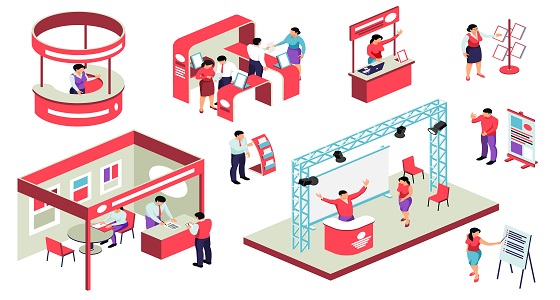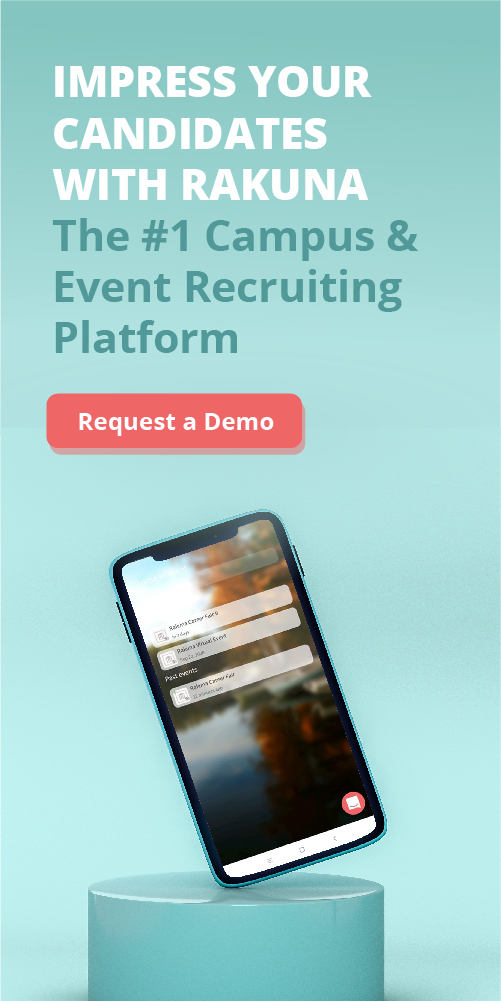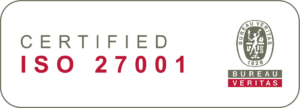Career fairs bring exciting opportunities for both job seekers and companies to learn about each other and interact. As an employer, these events give you chances to scout and attract the brightest students and fresh graduates. Thus, you should not only spend time preparing for career fairs but also evaluate your performance and identify areas for improvement in your event recruiting process.
To have the most accurate performance evaluation is to grasp the right statistics. Hence, event recruitment statistics are necessary tools to evaluate the success of events and optimize your performance. Understanding the following statistics can help you improve your campus recruitment strategy.
Pre-event Communication Effectiveness
Students actively seek job opportunities at campus recruitment fairs and on companies’ websites, making pre-event communication crucial. Rakuna’s Student Insights Report highlights that nearly 90% of students explore job prospects at career events, and two-thirds actively search for job postings on companies’ websites. Ensuring effective pre-event communication through the fair’s channels, company social media, and the official website is vital to enhancing awareness and attracting potential candidates to your booth.
Key Metrics to Monitor:
1. Number of Sign-ups
Tracking the count of participants who register for pre-event activities provides insight into the level of interest and engagement. High sign-up numbers indicate compelling pre-event content and effective outreach strategies.
2. Lead Awareness
Assessing how many potential candidates are aware of your company’s participation, through inquiries or surveys, helps evaluate the reach and resonance of your communication efforts.
3. Source of Awareness
Identifying where leads learned about your participation (e.g., fair channels, social media, website) enables you to pinpoint the most effective communication channels and allocate resources accordingly.
4. Cost per Lead
Calculating the average cost incurred for each lead generated through pre-event communication efforts allows for evaluation of the efficiency and cost-effectiveness of various strategies.
5. Engagement Rate
Measuring interactions with your pre-event content, such as social media likes, shares, and clicks, provides insight into the content’s appeal and effectiveness.
6. Survey Feedback
Collecting feedback through pre-event surveys helps understand participants’ expectations and perceptions, offering qualitative insights into the effectiveness of your communication strategy.
By closely monitoring these metrics, you can refine your pre-event communication strategies to better engage potential candidates and enhance the overall success of your recruitment events.
Attendance Data

Attendance data is a cornerstone among essential event recruiting statistics for every campus recruitment manager. Effectively evaluating your success in attracting the target group requires a comprehensive analysis of these key attendance metrics.
Key Metrics to Monitor:
1. Measuring Your Pull in the Crowd
The Metric: Booth Visitors vs. Total Event Attendees
What it Tells You: This straightforward ratio – the number of students who visited your booth compared to the total number of students at the event – is a primary indicator of your company’s overall magnetism.
Why it Matters: It’s a direct reflection of your pre-event marketing prowess and your team’s ability to draw students in on the day. A high ratio sings praises of your compelling employer brand and engaging booth presence. Conversely, a lower-than-expected ratio isn’t a failure, but rather a valuable signal that your pre-event hype or on-site appeal might need a strategic rethink.
Actionable Insights & Enhancements:
- Boost Your Beacon: Was your booth visually arresting and welcoming? An inviting design is non-negotiable.
- Create a Buzz: Interactive activities, live Q&A sessions, or even a well-promoted coffee station can significantly increase foot traffic.
- Amplify Anticipation: Did you generate excitement before the event? Teaser campaigns on university job boards, social media, or through academic departments, perhaps highlighting exclusive opportunities or early chat slots for attendees, can build anticipation.
2. Are You Connecting with the Right Talent?
The Metric: Booth Visitor Segmentation
What it Tells You: Moving beyond sheer numbers, categorizing your booth visitors by crucial criteria like academic year (freshman, sophomore, final-year graduate), major or area of interest, and even the specific roles they’re exploring, offers a much richer understanding of your audience.
Why it Matters: This segmentation is vital for assessing if you’re attracting your target demographic. Imagine attracting a large volume of visitors, only to discover the majority are first-year students exploring options, while your primary goal was to recruit imminent graduates for specific vacancies. This disparity is a clear call to action.
Actionable Insights & Enhancements:
- Tailor Your Message: Use clear, customized signage that speaks directly to different academic levels and career aspirations. “Graduate Opportunities Here!” or “Internships for Tech Majors” can filter and attract.
- Interactive Profiling: Brief, engaging digital surveys (e.g., on a tablet) can capture this data efficiently. Ask about their year, major, and top career interests.
- Spotlight Relevant Roles: Ensure your promotional materials and recruiter conversations actively highlight opportunities pertinent to your desired candidate pool.
- Year-Specific Engagement: Consider mini-information sessions or tailored discussion points specifically for fresh graduates, focusing on career trajectories and immediate openings. This shows you understand their unique position.
3. Understanding Geographic Reach
The Metric: Geographical Representation of Attendees
What it Tells You: This involves tracking the home universities, cities, or even regions of your booth visitors.
Why it Matters: This data helps you gauge the geographic effectiveness of your recruitment campaigns. Are you a strong magnet for local talent but missing out on candidates from further afield, or vice-versa? It highlights where your brand resonates powerfully and uncovers untapped regions ripe for exploration.
Actionable Insights & Enhancements:
- Targeted Outreach: If data reveals strong interest from a particular region, consider intensifying marketing efforts or even planning a dedicated event there.
- Forge University Alliances: If representation from key target universities is low, it’s a cue to strengthen relationships with their career services, faculty, or relevant student organizations.
4. How Engaged Are Your Visitors?
The Metric: Average Engagement Duration
What it Tells You: This measures the average length of time attendees spend at your booth, whether interacting with materials, participating in activities, or conversing with your recruitment team.
Why it Matters: A longer average engagement duration typically signals deeper interest and more meaningful interactions. Fleeting visits might indicate your messaging isn’t captivating enough, or that the initial attraction doesn’t translate into sustained interest.
Actionable Insights & Enhancements:
- Deepen the Interaction: Introduce problem-solving challenges, quick showcases of company culture, or hands-on tech demos that encourage attendees to linger and learn.
- Empower Your Recruiters: Train your team to move beyond generic spiels and initiate insightful, two-way conversations that genuinely capture a student’s attention and address their specific queries.
5. Identifying Highly Interested Candidates
The Metric: Return Visitor Count
What it Tells You: Noting attendees who visit your booth more than once during a multi-day event or even circle back later in the same day.
Why it Matters: Return visitors are a strong indicator of heightened and sustained interest. Their initial interaction was positive enough to draw them back, perhaps with more questions or a decision to engage more formally. This helps differentiate casual browsers from seriously interested candidates.
Actionable Insights & Enhancements:
- Cultivate Continued Engagement: Have a simple system (even a discreet note by recruiters) to recognize returners. Offer them a slightly different experience – perhaps a deeper dive into a program, an introduction to a more senior team member, or an invitation to an exclusive follow-up Q&A.
- Create Memorable Touchpoints: Ensure the overall booth experience – from the information shared to the demeanor of your team – is positive and memorable, making a second visit a natural next step for interested students.
Visitors’ Level of Engagement During Event

Attracting students to your booth is the first hurdle; transforming their fleeting curiosity into genuine engagement is where the real magic of event recruiting happens. The quality of interaction between your team and potential candidates offers a goldmine of insights into your employer brand’s magnetism and the efficacy of your event strategy. Let’s explore the pivotal elements that dictate visitor engagement levels and how to elevate them.
Key Metrics to Monitor:
1. Booth Design and Layout
The physical design and layout of your booth are more than just aesthetics; they are your company’s immediate handshake. Is it an open, welcoming space that invites exploration, or a cluttered, intimidating fortress?
Why It’s Crucial for Engagement: A well-thought-out booth immediately signals professionalism and care. Its visual appeal, intuitive flow, and accessibility directly influence a student’s decision to step in, stay awhile, and interact. A poorly designed space can be a silent deterrent, no matter how great your opportunities are.
Elevating the Experience:
- Craft Interactive Zones: Don’t just have a table and a backdrop. Designate specific areas for different interactions – perhaps a cozy corner for deeper conversations, a station for quick demos, or a spot for a fun, branded photo op.
- Maximize Brand Visibility (Tastefully): Your branding should be prominent, instantly recognizable, and visually appealing. It needs to cut through the noise of a busy career fair, conveying your identity clearly and attractively. Think clean lines, good lighting, and uncluttered messaging.
2. Employer Giveaways and Promotional Items
Employer giveaways and promotional items are a staple, but their true value lies in their relevance and memorability, not just their existence.
Why It’s Crucial for Engagement: Thoughtful giveaways can be excellent conversation starters and leave a lasting tangible reminder of your brand. However, generic items often end up forgotten. The goal is to offer something that resonates with your target audience and subtly reinforces your employer value proposition.
Elevating the Experience:
- Offer Targeted, Quality Giveaways: Ditch the cheap pens. Align your promotional items with the interests and values of the students you want to attract. Are they tech-focused? Consider a branded cable organizer or a useful app subscription. Eco-conscious? Perhaps a reusable tote or a plantable seed paper.
- Introduce an Element of Exclusivity: “Limited edition” or event-specific items can create a sense of urgency and make the takeaway feel more special, encouraging students to engage to receive one.
3. Company Representatives’ Performance
Your company representatives are the most dynamic and influential engagement tool you have. Their ability to connect, inform, and inspire is paramount.
Why It’s Crucial for Engagement: No amount of fancy tech or free swag can replace genuine human interaction. The effectiveness of your team in initiating meaningful conversations, adeptly answering tough questions, clearly articulating company culture, and generating genuine leads is the cornerstone of a successful event presence.
Elevating the Experience:
- Invest in Continuous Training: Equip your representatives with more than just company facts. Provide robust training on active listening, open-ended questioning, storytelling, and how to build rapport quickly and authentically.
- Empower Through Authentic Stories: Encourage your team to share their personal career journeys and genuine experiences within the company. These narratives resonate far more powerfully than scripted spiels and offer a real glimpse into your culture.
4. Technological Integration
Technology, when used strategically, can significantly amplify engagement, creating a modern and memorable booth experience. It’s about enhancing interaction, not replacing it.
Why It’s Crucial for Engagement: Interactive displays, virtual reality (VR) glimpses into your workplace, or seamless digital presentations can captivate attendees, particularly the tech-savvy generations. Observing how competitors leverage tech can also provide valuable benchmarks.
Elevating the Experience:
- Create Immersive Moments: For instance, if you’re a tech company, could a simple VR tour of your innovative lab space or a gamified coding challenge draw students in? The key is relevance and an experience they can’t get from a brochure.
- Leverage Dynamic Digital Content: Instead of static posters, use sleek digital screens to showcase company achievements, employee testimonials, or quick insights into available roles. Keep it visually engaging and easily digestible.
Visitors’ Level of Engagement Post-event

The conclusion of a career fair doesn’t mark the end of your engagement strategy—it’s a transition to the post-event phase, where sustained interactions and follow-up play a crucial role.
Measuring visitors’ responsiveness post-event provides valuable insights into the effectiveness of your outreach efforts and helps shape your ongoing recruitment strategy. Here’s a comprehensive look at the elements to consider when evaluating visitors’ engagement after the event:
Key Metrics to Monitor:
1. Social Media Interaction
After the event, how is your brand resonating in the digital sphere? Keep a keen eye on social media platforms for likes, shares, comments on your post-event content, and mentions of your company by attendees.
Why It Signals Continued Interest: This digital footprint reflects the lasting impression your event presence made. A vibrant online conversation indicates that attendees are still thinking and talking about their experience, extending your reach and engagement organically. Low interaction might suggest your post-event content isn’t hitting the mark or that the initial spark faded quickly.
Strategies to Amplify Engagement:
- Share Compelling Recaps: Post engaging content like “best of” event video montages, behind-the-scenes glimpses of your team, or insightful takeaways from keynote interactions.
- Visual Storytelling with Photo Albums: Create and share well-curated photo albums capturing the energy and memorable moments from the fair. Encourage tagging to boost organic reach.
- Interactive Follow-ups: Use polls (“What was your favorite part of our booth?”) or ask open-ended questions to reignite conversations and gather further informal feedback.
2. Newsletter and Email Engagement
Post-event emails and newsletters are your direct channels to nurture the interest sparked at the fair. Key metrics here include open rates, click-through rates (CTRs) on links within the email, and direct responses.
Gauging Receptiveness: These figures tell a story about the relevance and appeal of your communication. High open and click-through rates suggest your subject lines are compelling and the content within is valuable. Low engagement can indicate list fatigue, uninspiring content, or a disconnect with attendee interests.
Strategies to Boost Open & Click Rates:
- Personalize Your Outreach: Generic blasts are easily ignored. Segment your email lists based on interactions at the booth (e.g., interest in specific roles, year of study) and tailor content accordingly. A student who discussed engineering roles should receive different information than one interested in marketing.
- Deliver Ongoing Value: Don’t just sell. Showcase upcoming opportunities, share insightful company updates, spotlight employee success stories, or offer career advice relevant to their stage.
3. Job Opportunity Emails and Applications
This is where engagement begins to translate into tangible recruitment steps. Monitor how many targeted job opportunity emails are opened and clicked, and, crucially, how many subsequent applications are submitted by event attendees.
Measuring Conversion Intent: These metrics directly assess the effectiveness of your event in generating viable candidates. If students are opening emails about roles but not applying, there might be friction in the application process or a misalignment between the marketed role and its detailed description.
Strategies to Encourage Applications:
- Deliver Hyper-Relevant Job Alerts: Use data gathered at the event (e.g., from conversations or quick surveys) to send personalized job alerts that match attendees’ expressed preferences and qualifications.
- Simplify the Path to Apply: Ensure the application process linked from your emails is mobile-friendly, straightforward, and provides clear instructions. Offer points of contact for application assistance.
4. Follow-up Interviews and Conversations
The number of follow-up interviews scheduled or substantive conversations initiated by your team post-event is a strong indicator of successful lead nurturing.
Assessing True Potential: This metric moves beyond passive engagement to active consideration. It reflects how effectively your initial interactions and follow-up communications have converted event interest into a willingness to explore opportunities more deeply.
Strategies for Effective Follow-Ups:
- Strike While the Iron Is Hot: Initiate personalized follow-up communications within 24-48 hours of the event. This capitalizes on the recency of the interaction and shows proactivity.
- Reference Specific Interactions: Generic follow-ups are impersonal. Tailor messages by referencing specific discussions, questions asked, or interests expressed by the student during the event. This demonstrates genuine attention and care.
💡Before you start scheduling, here are 10 critical mistakes to avoid when checking candidates’ availability for interview.
5. Survey and Feedback Responses
Directly soliciting feedback through post-event surveys provides invaluable qualitative data on attendees’ overall experience, their perception of your booth and team, and their satisfaction levels.
Uncovering Actionable Insights: This feedback is your roadmap for improvement. It can highlight what you did well, where you fell short, and what students are truly looking for, enabling you to refine future event strategies and communication.
Strategies to Maximize Feedback Value:
- Incentivize Thoughtful Participation: Encourage higher response rates and more detailed feedback by offering small incentives, such as entry into a draw for a desirable prize, access to exclusive content, or a company-branded useful item.
- Commit to Continuous Improvement: Don’t let feedback sit in a spreadsheet. Actively discuss constructive criticism within your team and implement changes to continually enhance your post-event engagement and overall event experience.
6. Conversion Metrics
This is the bottom line – tracking how many post-event engagements ultimately convert into desired recruitment outcomes: applications from qualified candidates, successful interviews, and, most importantly, hires.
Quantifying Your Success & ROI: Conversion metrics provide a clear, quantifiable measure of your entire event and post-event strategy’s effectiveness in acquiring talent. They help justify event spend and pinpoint the most fruitful engagement tactics.
Strategies for Optimizing Conversions:
- Establish Clear Performance Benchmarks: Define what success looks like for your specific goals. Are you aiming for a certain number of applications from event attendees, or a specific interview-to-hire ratio?
- Embrace Iterative Optimization: Continuously analyze your conversion data. Which follow-up strategies yield the best results? Which channels are most effective? Use these insights to A/B test approaches and relentlessly refine your post-event engagement to align with evolving recruitment objectives.
Overall Event Recruiting Performance

While tracking specific career fair statistics at each stage is crucial, a comprehensive assessment of overall performance indicators provides a bird-eye view of the effectiveness and impact of your campus recruitment efforts. Here are key indicators that should be integral to your evaluation process:
Key Metrics to Monitor:
1. Total Engagement Metrics
This isn’t just about one type of interaction. It’s the sum total of individuals who actively engaged with any facet of your recruitment drive – from initial sign-ups and information requests to CV submissions and formal job applications.
Why It’s a Cornerstone Metric: This figure quantifies the overall magnetism and reach of your campus initiatives. A high total engagement suggests your messaging and activities are resonating widely, successfully drawing students into your talent ecosystem. It’s the first indicator of a healthy top-of-funnel.
Strategies for Broadening Impact:
- Amplify Through Promotion: Implement multi-channel, targeted promotional activities before, during, and after events to maximize visibility and draw in a diverse range of potential candidates.
- Ensure Seamless Interaction: All your platforms—from event registration pages to application portals—must be intuitive, mobile-friendly, and user-centric to encourage easy participation and prevent drop-offs.
2. Number of Qualified Candidates
This metric counts the individuals who not only engaged but were also identified as meeting your specific, predefined criteria for open roles or talent pipeline needs.
The Litmus Test for Targeting: This is where quantity meets quality. It directly gauges how successful your recruitment strategy is in attracting candidates who genuinely align with your hiring requirements. A high number here indicates effective targeting and clear communication of role prerequisites.
Strategies for Attracting the Right Fit:
- Continuously Refine Targeting: Your definition of a “qualified candidate” isn’t static. Regularly review and update your criteria based on evolving business needs, role requirements, and market talent availability.
- Craft Resonant, Tailored Messaging: Speak directly to the candidates you want to attract. Highlight the specific skills, experiences, and cultural attributes you’re seeking in your communications.
3. Cost per Candidate or Sign-Up
This involves meticulously calculating all recruitment-related expenditures—event costs, marketing campaigns, materials, travel, and team time—and dividing it by the number of engaged candidates or sign-ups achieved.
Evaluating Budget Effectiveness: This critical financial metric helps you assess the efficiency of your recruitment spend and the return on investment (ROI) for each candidate interaction. It highlights which channels and activities deliver the most bang for your buck.
Strategies for Optimizing Spend:
- Data-Driven Budget Allocation: Analyze your cost-per-candidate data rigorously. Reallocate budget from less effective channels or activities towards those that consistently deliver high-quality engagement at a lower cost.
- Iterate on Marketing Approaches: Continuously test and refine your marketing campaigns—from ad copy to channel selection—to improve reach and conversion while managing costs effectively.
4. Conversion Rates at Each Stage
This involves calculating the percentage of individuals who successfully move from one stage of your recruitment process to the next (e.g., from event sign-up to CV submission, from CV submission to first interview, from interview to offer).
Pinpointing Strengths and Bottlenecks: Analyzing these stage-by-stage conversion rates is like performing a health check on your recruitment funnel. It reveals where candidates are progressing smoothly and, more importantly, where they might be dropping off, indicating areas for process improvement or enhanced engagement.
Strategies for a Smoother Flow:
- Streamline and Simplify: Identify and eliminate any unnecessary complexities or friction points in your application and screening processes. Every extra click or confusing step can lead to candidate attrition.
- Personalize and Guide: Tailor your communication to address the specific needs and potential concerns of candidates at different stages. Proactive guidance can significantly improve progression rates.
5. Retention and Engagement Beyond Recruitment
This metric assesses how well you maintain connections with candidates who engaged with you, even if they weren’t hired for an immediate role. It looks at their continued interaction with your talent community, newsletter engagement, or responses to future opportunities.
The Strength of Your Talent Pipeline: Effective long-term engagement signifies that your strategies are building lasting relationships and a robust, warm talent pool for future needs. It’s about playing the long game in talent acquisition.
Strategies for Nurturing Future Talent:
- Develop Strategic Post-Event Nurturing: Implement ongoing engagement plans (e.g., targeted newsletters, webinars, skills-building content) to keep your brand top-of-mind and provide value to your talent community.
- Offer Exclusive Insights & Opportunities: Maintain interest by providing your talent pool with exclusive content, early access to new job postings, or invitations to special company events or Q&A sessions.
6. Brand Perception and Feedback
This involves systematically gathering and analyzing feedback on how students and candidates perceive your company as an employer, based on their interactions during and after your recruitment events.
Gauging Brand Impact and Reputation: This qualitative data provides invaluable insights into your employer brand’s strengths and weaknesses in the eyes of your target audience. It shows how your recruitment efforts are shaping your reputation in the market.
Strategies for Shaping a Positive Image:
- Establish Consistent Feedback Channels: Make it easy for engaged individuals to share their thoughts through surveys, informal check-ins, or social media listening.
- Proactively Manage and Enhance Brand: Use the feedback to identify areas for improvement. Continuously work on refining your employer value proposition and ensure your external messaging authentically reflects your internal culture.
Conclusion
In conclusion, knowing and understanding which career fair statistics to measure and monitor are needed to optimize your campus recruiting strategy. Recruiting teams should constantly track and monitor stats to keep your recruitment endeavors stay on track. You can use recruitment tools to optimize your performance, build an effective strategy, and stay ahead of your competitors.

Team Rakuna
The Rakuna Team comprises a diverse group of professionals hailing from various corners of the world.
With a passion to enable organizations to hire their next waves of talents, we are dedicated to help organizations stay updated on important recruiting technology and industry best practices.



